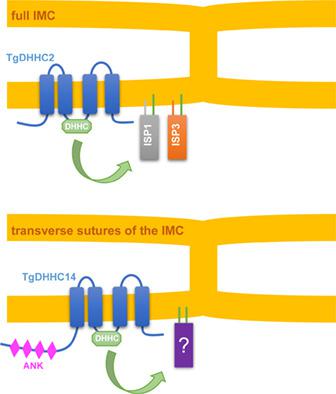当前位置:
X-MOL 学术
›
Cell. Microbiol.
›
论文详情
Our official English website, www.x-mol.net, welcomes your feedback! (Note: you will need to create a separate account there.)
Two palmitoyl acyltransferases involved sequentially in the biogenesis of the inner membrane complex of Toxoplasma gondii.
Cellular Microbiology ( IF 3.4 ) Pub Date : 2020-04-23 , DOI: 10.1111/cmi.13212 Sunil Kumar Dogga 1 , Karine Frénal 1
Cellular Microbiology ( IF 3.4 ) Pub Date : 2020-04-23 , DOI: 10.1111/cmi.13212 Sunil Kumar Dogga 1 , Karine Frénal 1
Affiliation

|
The phylum Apicomplexa includes a number of significant human pathogens like Toxoplasma gondii and Plasmodium species. These obligate intracellular parasites possess a membranous structure, the inner membrane complex (IMC), composed of flattened vesicles apposed to the plasma membrane. Numerous proteins associated with the IMC are anchored via a lipid post‐translational modification termed palmitoylation. This acylation is catalysed by multi‐membrane spanning protein S‐acyl‐transferases (PATs) containing a catalytic Asp‐His‐His‐Cys (DHHC) motif, commonly referred to as DHHCs. Contrasting the redundancy observed in other organisms, several PATs are essential for T. gondii tachyzoite survival; 2 of them, TgDHHC2 and TgDHHC14 being IMC‐resident. Disruption of either of these TgDHHCs results in a rapid collapse of the IMC in the developing daughter cells leading to dramatic morphological defects of the parasites while the impact on the other organelles is limited to their localisation but not to their biogenesis. The acyl‐transferase activity of TgDHHC2 and TgDHHC14 is involved sequentially in the formation of the sub‐compartments of the IMC. Investigation of proteins known to be palmitoylated and localised to these sub‐compartments identified TgISP1/3 as well as TgIAP1/2 to lose their membrane association revealing them as likely substrates of TgDHHC2, while these proteins are not impacted by TgDHHC14 depletion.
中文翻译:

两种棕榈酰酰基转移酶依次参与弓形虫内膜复合物的生物发生。
Apicomplexa 门包括许多重要的人类病原体,如弓形虫和疟原虫物种。这些专性细胞内寄生虫具有膜结构,即内膜复合物 (IMC),由与质膜并列的扁平囊泡组成。许多与 IMC 相关的蛋白质通过称为棕榈酰化的脂质翻译后修饰锚定。这种酰化由包含催化 Asp-His-His-Cys (DHHC) 基序的跨膜蛋白 S-酰基转移酶 (PAT) 催化,通常称为 DHHC。与在其他生物中观察到的冗余相比,几个 PAT 对弓形虫来说是必不可少的速殖子存活;其中 2 个,TgDHHC2 和 TgDHHC14 是 IMC 驻留的。这些 TgDHHC 中的任何一个的破坏都会导致发育中的子细胞中 IMC 的快速崩溃,从而导致寄生虫的显着形态缺陷,而对其他细胞器的影响仅限于它们的定位,而不是它们的生物发生。TgDHHC2 和 TgDHHC14 的酰基转移酶活性依次参与 IMC 子室的形成。对已知被棕榈酰化并定位于这些亚区室的蛋白质的研究确定了 TgISP1/3 和 TgIAP1/2 失去了它们的膜结合,表明它们可能是 TgDHHC2 的底物,而这些蛋白质不受 TgDHHC14 消耗的影响。
更新日期:2020-04-23
中文翻译:

两种棕榈酰酰基转移酶依次参与弓形虫内膜复合物的生物发生。
Apicomplexa 门包括许多重要的人类病原体,如弓形虫和疟原虫物种。这些专性细胞内寄生虫具有膜结构,即内膜复合物 (IMC),由与质膜并列的扁平囊泡组成。许多与 IMC 相关的蛋白质通过称为棕榈酰化的脂质翻译后修饰锚定。这种酰化由包含催化 Asp-His-His-Cys (DHHC) 基序的跨膜蛋白 S-酰基转移酶 (PAT) 催化,通常称为 DHHC。与在其他生物中观察到的冗余相比,几个 PAT 对弓形虫来说是必不可少的速殖子存活;其中 2 个,TgDHHC2 和 TgDHHC14 是 IMC 驻留的。这些 TgDHHC 中的任何一个的破坏都会导致发育中的子细胞中 IMC 的快速崩溃,从而导致寄生虫的显着形态缺陷,而对其他细胞器的影响仅限于它们的定位,而不是它们的生物发生。TgDHHC2 和 TgDHHC14 的酰基转移酶活性依次参与 IMC 子室的形成。对已知被棕榈酰化并定位于这些亚区室的蛋白质的研究确定了 TgISP1/3 和 TgIAP1/2 失去了它们的膜结合,表明它们可能是 TgDHHC2 的底物,而这些蛋白质不受 TgDHHC14 消耗的影响。


























 京公网安备 11010802027423号
京公网安备 11010802027423号